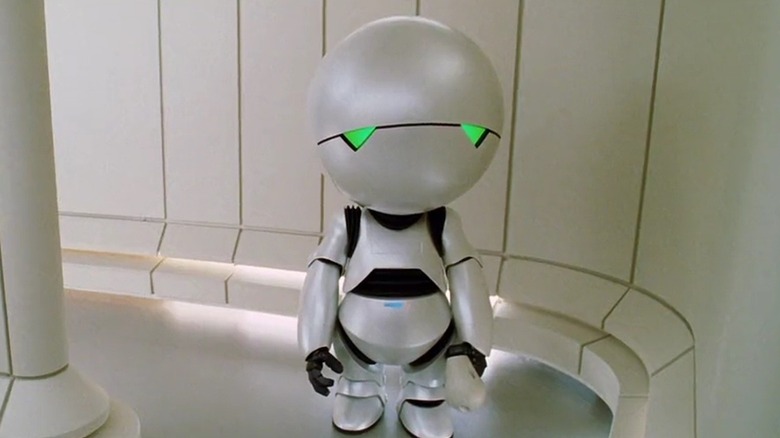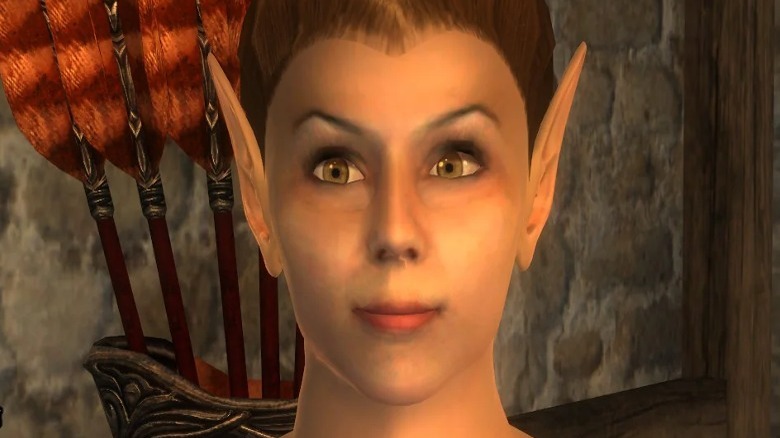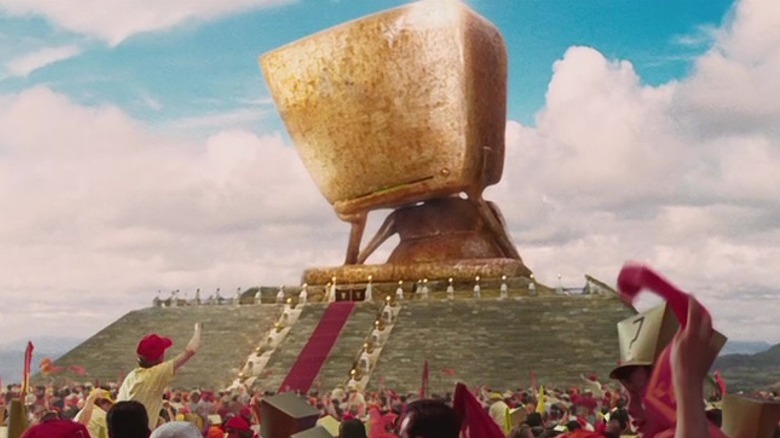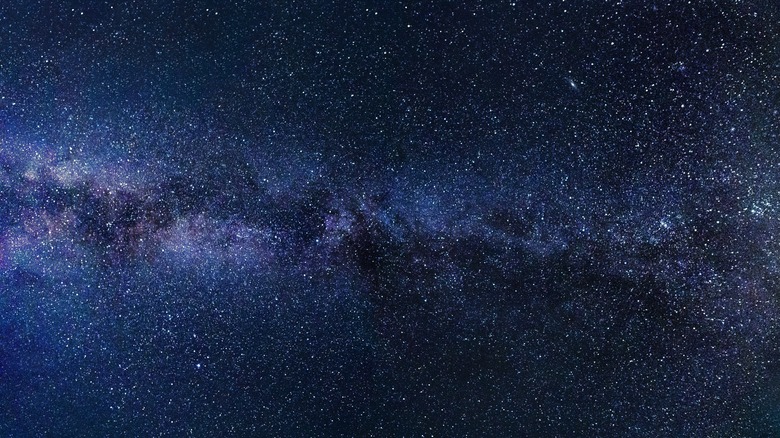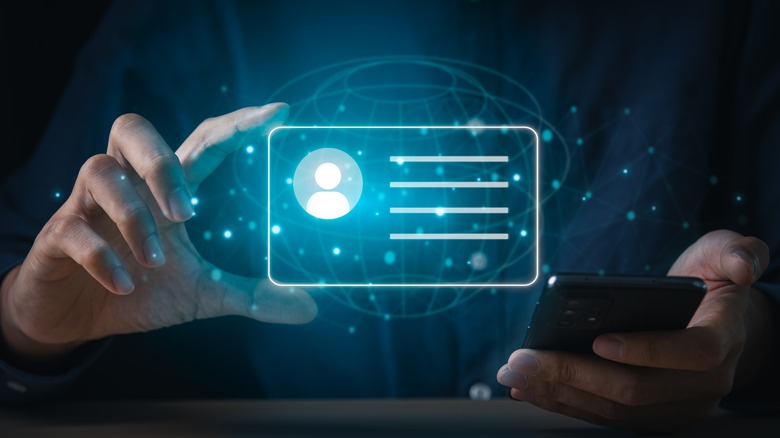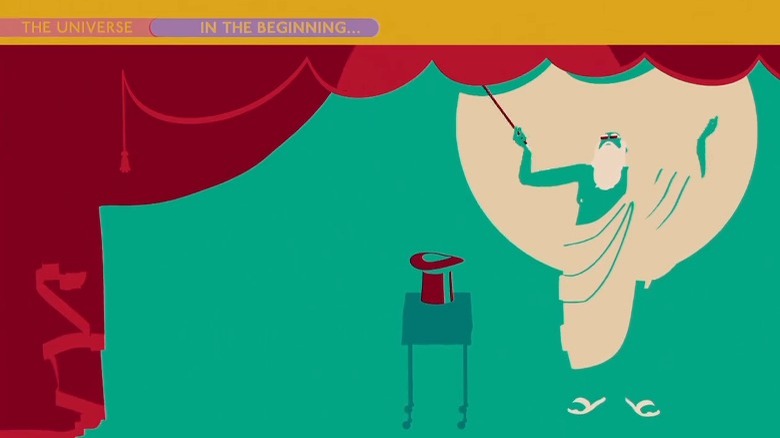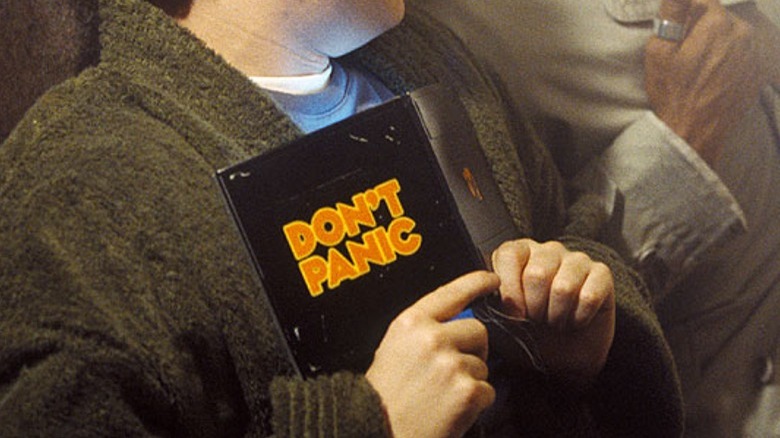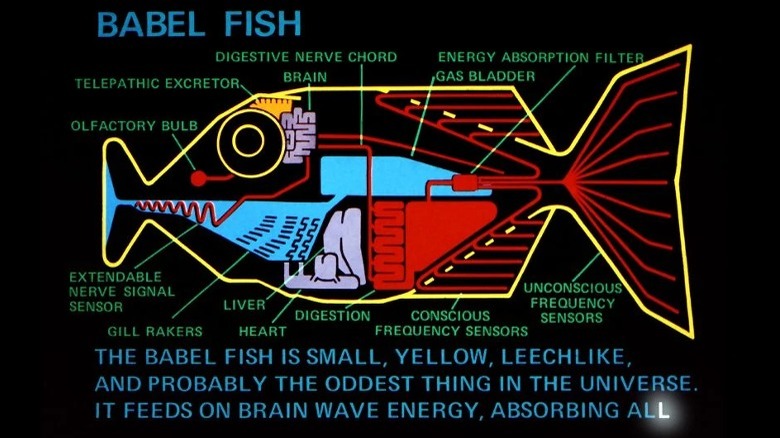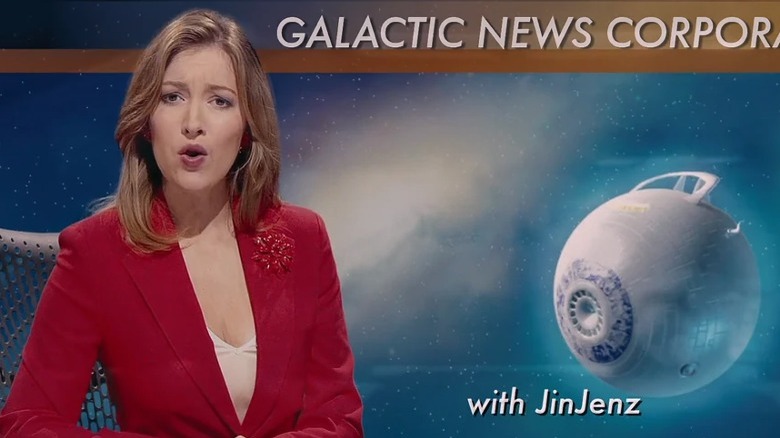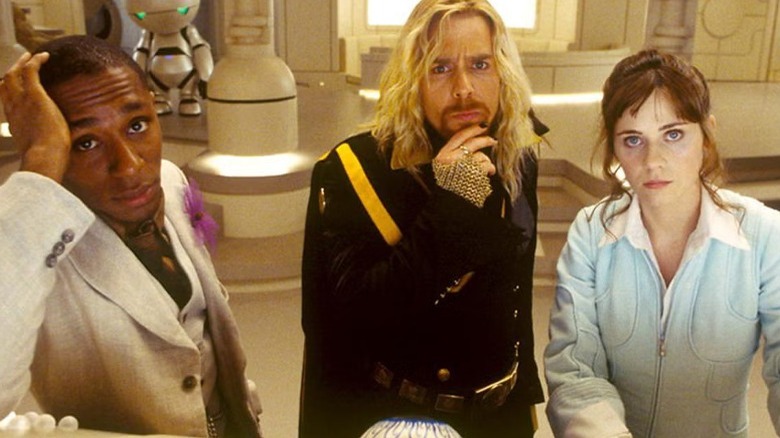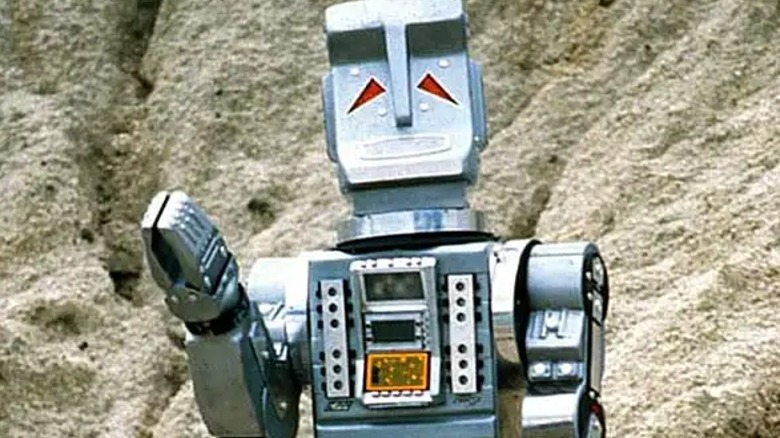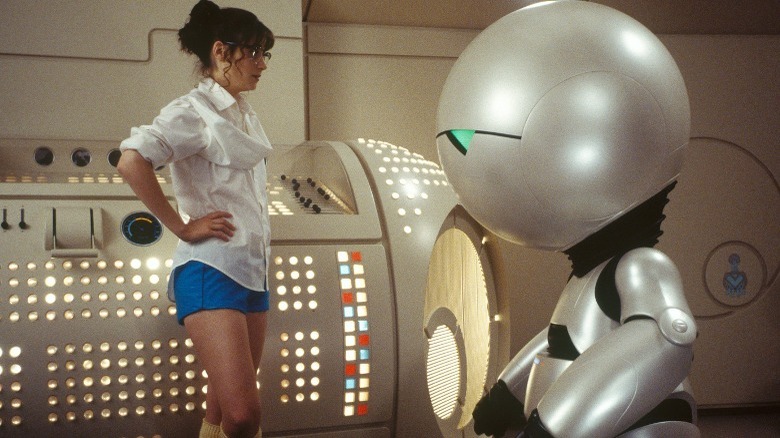All The Technology Hitchhiker's Guide To The Galaxy Predicted Correctly
Science fiction has always had a way of predicting the future. The very fact that the genre often looks to upcoming periods of time allows its creators to imagine what life might be like as technology advances and becomes more widespread. In many cases, science fiction novels, movies, and television shows will forecast the future very wrong — we still don't have flying cars, after all.
However, a lot of sci-fi releases have been eerily accurate when it comes to prophesying pieces of tech. Novels in the "Hitchhiker's Guide to the Galaxy" series By Douglas Adams have proved to be particularly prescient when it comes to foreseeing what types of technology people would be using in the future.
While Adams wasn't actively trying to predict the future with his sci-fi comedy franchise, much of the technology referenced in the "Hitchhiker's Guide" series has since come into existence. Although we are still waiting for the Infinite Improbability Drive, there are lots of other gadgets, equipment, and technology from the "Hitchhiker's Guide to the Galaxy" that we now use.
By-products of Designer People
Much of the technology in "The Hitchhiker's Guide to the Galaxy" comes from the Sirius Cybernetics Corporation. This is a company that proves to be pretty useless throughout the series, with its products either not working as intended or possessing quirky and unexpected malfunctions. Specializing in devices that are meant to improve people's lives by saving time or making jobs easier, most of them also feature Genuine People Personalities. This essentially gives the robots and products some semblance of sentience.
In the short story "Young Zaphod Plays it Safe," Sirius Cybernetics offers personalized synthetic personalities for sale. These AI didn't work as designed, though, and are described as "amalgams of characteristics which simply could not co-exist in naturally occurring life forms." They go on to take on lives of their own and are willing to do anything as they aren't bound by inhibitions. You can think of them as AI that have gone rogue and decided to abandon what they were originally programmed to do and set out to live as they see fit. One is even suggested to have come to Earth and lived as a man known as Ronald Reagan.
The idea of AI running amok and doing whatever they please might sound like the realm of science fiction but it is something that has been demonstrated. When Bethesda implemented the revolutionary Radiant AI system in "The Elder Scrolls III: Oblivion" the NPCs rampaged. The system had to be massively scaled back and NPCs given less freedom to stop the artificial world descending into chaos as the population killed each other.
Deep Thought
Anyone who has read "The Hitchhiker's Guide to the Galaxy" or seen adaptations of the work will undoubtedly know about the supercomputer Deep Thought. It plays a central part in the novel, having been built by an unnamed "pan-dimensional, hyper-intelligent species of beings." Huge and incredibly complex, Deep Thought is the size of a city and is designed to answer questions put to it by its creators. In particular, the supercomputer is designed to answer the Ultimate Question of Life, the Universe, and Everything.
Unfortunately, the nature of the question means that it takes Deep Thought 7.5 million years to compute the answer. It finally reveals the Ultimate Answer is 42, disappointing and confusing the entire species of its creators. Afterwards, the dismayed followers of Deep Thought work with the computer and the Magratheans to design a new computer in the form of Earth that will be able to fully define the Ultimate Question and give more meaning to the answer.
The idea of an artificial intelligence that can answer questions given to it by users would have been fanciful at the time that "The Hitchhiker's Guide to the Galaxy" was released. However, it has since become reality. Smart speakers such as Alexa and Google's Nest can reply to questions spoken to them, while chatbots such as ChatGPT are specifically designed to respond to prompts. Like Deep Thought, these systems often provide answers that are not exactly what you might expect, and ChatGPT has even said some very creepy things.
Total Perspective Vortex
Total Perspective Vortex is the result of an invention by Trin Tragula, a man who wanted to be able to see the whole of the universe. It's also a way of proving his nagging wife wrong, who tells him that he needs to have a sense of proportion rather than spending his time looking up at the stars. Using the theory of atomic interactivity, Tragula was able to extract the entirety of creation from a single fairy cake as every single atom connects with every other atom in the universe.
Using the Total Perspective Vortex is nearly always fatal as the sheer size and vastness of creation is practically impossible to comprehend. Tragula's wife dies when the device destroys her mind in "The Hitchhiker's Guide to the Galaxy" radio series, and it has since been used as a torture device to utterly demoralize and crush the spirit of any victim by showing how insignificant and unimportant they are.
While the Total perspective Vortex is obviously not something that can be replicated in real life, there is now similar technology that can give people a view of the cosmos. The Google Earth mobile app now displays real-life positions of the stars when users zoom out of our planet. There's also a variety of great astronomy apps that can tell you what you are looking at in the night sky and provide a map of the constellations and far off stars.
Ident-i-Eeze
"Mostly Harmless," the fifth book in the "Hitchhiker's Guide to the Galaxy" trilogy, Ford Prefect is able to alter the credit of the Dine-O-Charge to essentially provide himself with unlimited funds. He does this by stealing the Ident-I-Eeze card of his new boss Vann Harl. This small plastic card, which resembles a credit card in size and shape, provides Prefect with everything he needs to pretend that he is Harl and access the company's financial data.
That's because the Ident-I-Eeze acts as an all-in-one solution for identity security. It contains all of the biometric data, passwords, and security answers that can help identify a person. In essence, the Ident-I-Eeze holds every piece of information about a person to make it easy to prove who you are.
The Ident-I-Eeze predated several types of technology we have in modern times. Smartphones use passkeys to allow users to log into their various accounts using biometric data such as fingerprints and face recognition. Apple also offers a service known as NameDrop that allows users to share information about them in the form of contact cards by bumping devices together. Meanwhile, one company has also launched a business card that is a Linux computer that, in the future, may well be able to hold the same kind of identifying data as the Ident-I-Eeze.
The Hitchhiker's Guide to the Galaxy
At the heart of "The Hitchhiker's Guide to the Galaxy" is the titular electronic guide book. Emblazoned with the words "Don't Panic" on the cover, Douglas Adams described it in the novel series as the "standard repository for all knowledge and wisdom" in the universe. It contains millions of entries about everything a hitchhiker would need to know while traveling around space to different planets, including information about worlds, species, technology, and life itself. While there are professional editors who contribute to the guide, much of the work is done by random people who "happened to wander into the empty offices of an afternoon and saw something worth doing."
If you ignore the comedy and satire of "The Hitchhiker's Guide of the Galaxy," the concept probably sounds pretty familiar — it is basically Wikipedia. There are a lot of parallels between Wikipedia and the Guide, ranging from the fact that they can both be edited by anyone and contain entries on almost every topic imaginable. The fictional guide is also frequently wrong or apocryphal, something that Wikipedia has been accused of.
Thin flexible lap computers
In Douglas Adams' work, the guide is usually described as being done sort of like a laptop. In The book "So Long, and Thanks for All the Fish" the guide is said to be "a small, thin, flexible lap computer" while Ford Prefect also goes on to suggest it is a "sort of electronic book." Meanwhile, in the first novel, the actual design of the guide is said to have "about a hundred tiny flat press buttons and a screen about four inches square."
With the "Hitchhiker's Guide to the Galaxy" arriving in the late 1970s, the radio series and novel predated modern personal computers. In fact, it wasn't until the 1980s that personal computers became available commercially. But even these computers were hulking machines, with large CRT monitors, bulky towers, and heavy equipment. To use them you definitely needed a desk or workstation and they were far from portable.
It wasn't until the late 1980s and early 1990s that recognizable laptops started to enter the market. Later advances saw laptops get smaller and the development of tablets matches even more closely the description of the guide in Douglas Adams' work. Depictions of the guide in adaptations closely resemble modern tablets and e-readers, essentially making the guide itself a precursor to these types of devices.
Folding Screens
Flip phones were all the rage during the late 1990s and early 2000s. That popularity was well merited, given that the folding design made sense and allowed manufacturers to shrink down the form of the devices when they weren't being used. However, the advent of smartphones with large touch screens largely put an end to them, as customers preferred the larger screens.
Now things are changing again, and folding phones are making a comeback. There are some great Android foldable phones, made possible thanks to new technology that allows touch screens to bend and have much more flexibility without suffering damage. That's something that Douglas Adams included in his work, although not in the original novels or radio series.
A folding version of the guide appears in the 2005 film adaptation. Adams co-wrote the movie's screenplay, having completed his final draft before his death in 2001 — with Karey Kirkpatrick later working on the script. The film depicts the guide as more like a traditional book that can be opened up to reveal a digital screen that bends at the spine.
Babel Fish
Out of all the technology within "The Hitchhiker's Guide to the Galaxy," the Babel FIsh is perhaps the strangest. It is a living creature rather than an artificial construct but also one of the most important things in the galaxy as it essentially allows every race of beings from every corner of space to communicate with each other seamlessly. The small yellow fish can be placed in the ear of any individual where it will then instantly translate any spoken language into the mother tongue of the person it now calls home. The Babel Fish essentially feeds on brain waves, converting them and then communicating telepathically to its host.
When "The Hitchhiker's Guide to the Galaxy" first arrived, the idea of instantaneous translation likely seemed almost impossible, but the technology to be able to do this without the help of a human translator is actually available right now. In fact, you can get in-ear translations just like in the sci-fi series — without the need for a fish — through the use of earbuds. Google's Pixel Buds can translate conversations in real time. When using the Pixel Buds, you can even have your speech automatically translated through a phone speaker as you talk.
Sub-Etha
Wireless data networks were not completely unheard of when "The Hitchhiker's Guide to the Galaxy" was first published — in fact they had been available for sometime — but they were not used like they are today. Modern wireless systems such as Wi-Fi and 5G make it possible to do everything you can do with a wired connection while on the go. You can stream content, get updates for your games and software, and even upload data. Essentially, wireless technology now allows you to communicate around the world instantaneously.
The importance of wireless connections and systems was made clear in "The Hitchhiker's Guide to the Galaxy." In the franchise, the Sub-Etha is a faster-than-light communications network that allows hitchhikers and other individuals to communicate across the universe or get news about current events. It is largely used to hail passing spaceships, but it is also important in allowing editors and writers to send new entries to the guide for publishing and allowing users to download updates that include corrections and extra content. It works almost exactly like the internet we have today, but is not limited by the speed of light.
Gesture and touch controls
The technology within "The Hitchhiker's Guide to the Galaxy" has advanced to the point that pressing buttons on devices is no longer necessary. Instead, users can interact with their devices in more intuitive ways, without needing electronic equipment with buttons, knobs, dials, or joysticks. The original novel notes that as " technology became more sophisticated the controls were made touch-sensitive — you merely had to brush the panels with your fingers."
In the same passage, the book notes that touch controls were not the only way that technology has advanced. Gesture-based controls were now also a thing, which meant you only had to "wave your hand in the general direction of the components and hope."
This is something that anyone who has used any sort of modern technology in real life will have experienced. Almost every smartphone, tablet, and e-Reader now uses a touch screen for most functionality. Many devices also incorporate touch-free controls in some way. You can perform many functions on an iPhone using gestures and things like the Xbox Kinect work entirely through interpreting a person's movements with a camera. The book even predicts the occasionally imprecise nature of gesture-based systems.
Genuine People Personalities
One of the most common aspects of technology in the "Hitchhiker's Guide to the Galaxy” is that almost all of the devices, robots, and equipment appear to have personalities of some form. Everything from Marvin the Paranoid Android to the onboard ship computer for the Heart of Gold have unique personalities and can talk with the other characters. In fact, even the likes of doors, toasters, and elevators all speak as well, usually with cheery dispositions.
This is the result of the Sirius Cybernetics Corporation including an invention known as Genuine People Personalities in all of its products. It essentially gives its devices some artificial intelligence and emotional capability, often to the annoyance of those trying to use them. These differ from By-products of Designer People as Genuine People Personalities are simply devices or robots that have been given some sort of personality rather than being an out-of-control AI.
That's something that people today are now just starting to get used to. More and more technology is being imbued with artificial intelligence and many products today, such as virtual assistants like Alexa and Siri, seemingly have personalities of their own. We are already at a point where we can talk to our gadgets and have them respond, and this will likely only become more prevalent in the future.
Voice Control
As a result of many gadgets and technology within "The Hitchhiker's Guide to the Galaxy" having personalities, they are designed to be able to not only speak to people, but also listen to what they have to say. In fact, voice controls are clearly the most widely used way of interacting with equipment in the franchise, whether it's with the Heart of Gold's ship computer or Colin the security robot. The series is simply filled with examples of characters talking to devices and ordering them to carry out tasks without having to physically press buttons or perform gestures.
That's something that has emerged within our own technology in recent years. It is not unusual to see people talking into their phones or speaking to gadgets to operate them. We can do everything from calling a friend and emailing a colleague to turning on the air conditioning and switching on lights with vocal commands. With there being so many smart home devices that you've never even heard of available today, voice controls are only going to become more common.
Nutrimatic Drinks Dispenser
The Nutrimatic Drinks Dispenser — also known as the Nutrimat Machine or Nutri-Matic Drinks Dispenser depending on the adaptation — is a special type of vending machine with "The Hitchhiker's Guide to the Galaxy." Like most of the inept technology within the franchise, it is the work of the Sirius Cybernetics Corporation. The machine analyzes users' taste buds and neurological signals before creating a personalized beverage based on their unique profile. Unfortunately for Arthur Dent, it more often than not concocts something resembling tea but not quite tea.
While there haven't been any machines that can read your mind or read your tongue, there are some recent inventions that create personalized drinks for each user. Innovative Vending has a range of vending machines that allow customers to input taste preferences, nutritional needs, and fitness goals to get a blended drink that is the perfect match for them. Another company, called Cana, has developed a molecular drinks printer. Using a single cartridge, it can make hundreds of different drinks to suit the needs of the user.
